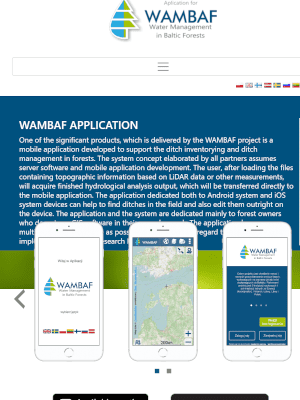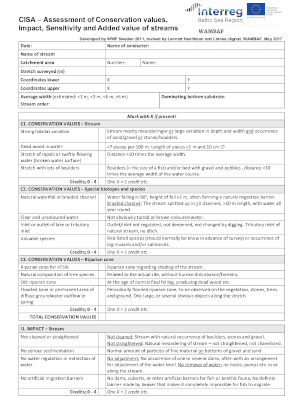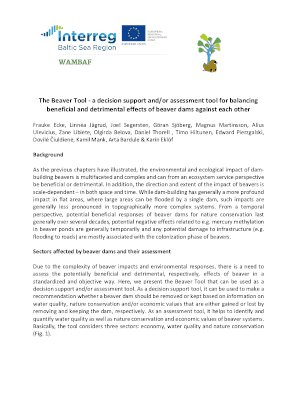WAMBAF
Harmful dispatch from forests
Forests cover 48% of the Baltic Sea catchment and are accountable for about 19% of the total nitrogen and 16% of the phosphorus load to the sea, according to Baltic Marine Environment Protection Commission (HELCOM). Forest streams and rivers take nutrients and hazardous substances, such as methyl mercury, directly to the regional and coastal waters. In this way, they add to the eutrophication and pollution of the Baltic Sea water and decrease of biodiversity.
Missing coordination across the region
The main drivers of change in the inflow of nutrients and hazardous substances is better maintenance of forest drainage systems, management of riparian forests, and distribution of beaver dams. To date, however, authorities responsible for the forestry in the countries around the Baltic Sea have applied various, often barely cost-effective water protection practices without coordinating the efforts with the neighbouring countries. With better knowledge and efficient tools in place, the authorities, as well as forest enterprises, forest owners and hunters could more effectively plan operations in riparian forests, decide which drainage systems to keep and assess which beaver dams have the best capacity to decrease the amounts of nutrients and hazardous substances in waters.
Budgets
in numbers
-
2.93MillionTotal
-
2.28MillionErdf
-
0.00MillionEni + Russia
-
0.00MillionNorway
Achievements
New tools for managing forests
National forest and environment ministries and agencies in Lithuania and Sweden, the state-owned forest enterprise that manages one-third of Finland’s land area, and forest institutes in these countries as well as in Latvia and Poland pooled their expertise and experience in the project WAMBAF in order to jointly develop a mobile app tool for maintaining forest drainage systems, a planning tool for riparian forest buffers, and a decision support tool for beaver dams.
Over 620 representatives from private and state-owned forest enterprises, forest owners, hunters, and authorities attended training courses to test them directly in the forest and provide feedback on their usability. Over two-thirds of the participants said that these tools would be useful to them in their daily forestry work. These tools can help users balance the various forest management goals, such as producing timber while safeguarding water quality.
Demonstration areas
The project set up physical demonstration areas where private and state-owned forest enterprises, forest owners and authorities witnessed good practices in forest water management. These eleven demonstration areas were located in Vengasoja, Finland; Jaunkalsnava, Latvia; Plateliai and Kretinga, Lithuania; Sokolak, Strazalowo (two areas) and Żednia, Poland; and Kungsberget, Tobo, Torringen, and the Helgeå watershed, Sweden.
The area in Sokolak, Poland, for example, demonstrated that it is possible to retain drainage water from agricultural areas in mid-forest ponds and assessed the effects of this solution on trees and groundwater quality around the reservoir.
The biggest forest enterprise in Sweden, Sveaskog, reached out to the Finnish state-owned forest enterprise Metsähallitus to arrange a visit to the demo area in Vengasoja to learn more about the results developed in WAMBAF.
Cleaner waters in forests
With EUR 2.28 million invested by the European Union, the Interreg project WAMBAF not only filled a knowledge gap of water management in forests by creating easy-to-use tools for authorities, planners, forest owners, forest managers and hunters, it introduced the tools to these intended users in 19 training courses around the Baltic Sea. Now the follow-up project WAMBAF Tool Box, puts these tools into practice by training more users to use them.
On the demo areas that were already established, Latvian forest managers, machine operators and contractors, and Estonian forest administrators, managers and operators are learning how to use the ditch management application. Lithuanian forest managers and hunters as well as relevant stakeholders from various countries in the region are training how to use the beaver tool, whereas Polish state forest managers are practising the blue targeting tool.
Outputs
Ditch management tool

Blue targeting tool

Beaver tool

Project Stories
Partners
Swedish Forest Agency
- TownBorås
- RegionVästra Götalands län
- CountrySweden
- RepresentativeDaniel Thorell
- Phone
- E-Mail
- Web
Institute Natural Resources Finland (Luke)
- TownJoensuu
- RegionPohjois-Karjala
- CountryFinland
- RepresentativeLeena Finér
- Phone
- E-Mail
- Web
Metsähallitus
- TownVantaa
- RegionPäijät-Häme
- CountryFinland
- RepresentativeTimo Hiltunen
- Phone
- E-Mail
- Web
Latvian State Forest Research Institute Silava
- TownSalaspils
- RegionPierīga
- CountryLatvia
- RepresentativeToms Zalitis
- Phone
- E-Mail
- Web
Lithuanian Research Centre for Agriculture and Forestry (LRCAF)
- TownKėdainiai dirstrict
- RegionKauno apskritis
- CountryLithuania
- RepresentativeMarius Aleinikovas
- Phone
- E-Mail
- Web
Ministry of Environment of the Republic of Lithuania
- TownVilnius
- RegionVilniaus apskritis
- CountryLithuania
- RepresentativeZbignev Glazko
- Phone
- E-Mail
- Web
Forest Research Institute (IBL)
- TownSękocin
- RegionWarszawski zachodni
- CountryPoland
- RepresentativeRadomir Bałazy
- Phone
- E-Mail
- Web
the Forestry Research Institute of Sweden
- TownUppsala
- RegionUppsala län
- CountrySweden
- RepresentativeLars Högbom
- Phone
- E-Mail
- Web
Swedish University of Agricultural Sciences (SLU)
- TownUppsala
- RegionUppsala län
- CountrySweden
- RepresentativeFrauke Ecke
- Phone
- E-Mail
- Web
-
Project managerDaniel ThorellSwedish Forest Agency
-
Legal representativeJohanna FromSwedish Forest Agency
-
Financial managerIngegerd AnderssonSwedish Forest Agency
-
Communication managerAndrea JonssonSwedish Forest Agency



